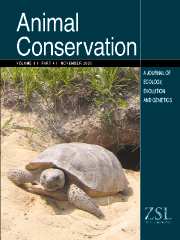Article contents
High effective inbreeding coefficients correlate with morphological abnormalities in populations of South Australian koalas (Phascolarctos cinereus)
Published online by Cambridge University Press: 29 August 2001
Abstract
Koalas have undergone a series of sequential founding events on islands in south-eastern Australia in recent times. Populations in South Australia at the Eyre Peninsula and Mt Lofty Ranges were founded in the 1960s from a colony on Kangaroo Island. The Kangaroo Is. colony was derived from animals introduced to French Island from mainland Victoria over a century ago. In this study, we first use microsatellite markers to quantify levels of genetic variation within the South Australian koala populations and the relatively unperturbed Strzelecki Ranges population from mainland Victoria. This analysis revealed low levels of allelic diversity (1.7 ± 0.2 to 2.7 ± 0.5) and heterozygosity (0.208 ± 0.088 to 0.340 ± 0.110) in the three South Australian koala populations relative to the Strzelecki Ranges population, which has the highest levels of allelic diversity (4.7 ± 1.1) and heterozygosity (0.476 ± 0.122) in Victoria. Second, we measured the incidence of testicular aplasia, a unilateral or bilateral failure in testicular development, in the Eyre Peninsula and Kangaroo Is. populations, and in the ultimate founding population at French Is. Testicular aplasia was present at a frequency of 4.3% in French Is., 12.8% in Kangaroo Is. and 23.9% in the Eyre Peninsula, but was undetectable in the non-bottlenecked Pilliga State Forest population of New South Wales. The incidence of testicular aplasia correlated positively with effective inbreeding coefficients derived from heterozygosity values (0.13 ± 0.06 in the Pilliga State Forest, 0.57 ± 0.17 in French Is., 0.63 ± 0.12 on Kangaroo Is. and 0.77 ± 0.12 in the Eyre Peninsula), which may indicate inbreeding depression. These findings are of concern when evaluating the long-term conservation and viability of the South Australian koala populations, which may benefit from genetic augmentation in the future. Finally, unconfirmed reports suggested that animals from other states in Australia were introduced into the Mt Lofty Ranges population. Therefore, we quantified differentiation between the three South Australian populations and the Strzelecki Ranges and French Is. populations, based on microsatellites and mtDNA d-loop region variation. R-statistics and Goldstein's delta mu square distance revealed that differentiation at nuclear loci between populations paralleled known recent population history, except for the close relationship between Mt Lofty Ranges and French Is. This suggested a recent contribution to the Mt Lofty Ranges populations of animals derived from the French Is. translocation program. Furthermore, mtDNA d-loop analysis found no evidence of contributions to the gene pool from animals of New South Wales or Queensland stock, implying that the population was derived exclusively from Victorian stock.
- Type
- Research Article
- Information
- Copyright
- © 2001 The Zoological Society of London
- 51
- Cited by


